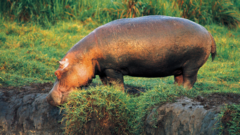At least 50 hippos and various large animals in Virunga National Park, the oldest national park in Africa, have tragically died due to anthrax poisoning, according to reports from park officials. Images shared by the Virunga team show the lifeless creatures floating down the Ishasha River, with the first sightings of these fatalities beginning last week. While the precise origin of the anthrax outbreak remains uncertain, tests have confirmed its presence in the area.
Emmanuel De Merode, the park's director, reported that efforts are underway to recover the deceased animals and bury them in order to prevent further contamination, a task made challenging due to lack of excavation equipment and access limitations. "We have the means to limit the spread by... burying them with caustic soda," De Merode told Reuters.
The Ishasha River flows north towards Lake Edward, noted as one of Africa's major lakes, where reports of additional dead animals have emerged. Anthrax, caused by the bacterium Bacillus anthracis, can be lethal; however, it typically does not spread easily among animals. This persistent bacteria often survives as resilient spores in the soil for many years, waiting to infect hosts via inhalation or through wounds.
The Congolese Institute for the Conservation of Nature has issued warnings to local residents, urging them to steer clear of wildlife and to boil any water sourced from local bodies before consumption. Covering an expanse of 7,800 square kilometers (around 3,000 square miles), Virunga is recognized for its remarkable biodiversity but has also gained notoriety due to ongoing conflicts between various armed rebel groups and the Congolese military.
These hostilities have claimed the lives of numerous park rangers who dedicate themselves to wildlife protection. Over the past several decades, significant initiatives have been put in place to restore the hippo population in the park, which drastically plummeted from over 20,000 to merely a few hundred owing to actions related to poaching and warfare. The situation in this region suggests that the battle for wildlife preservation is no small feat.



















